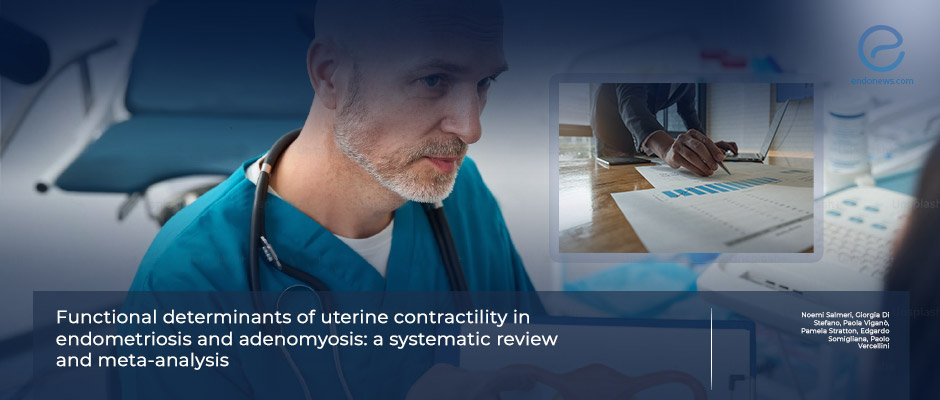The Role of Uterine Contractility in Endometriosis and Adenomyosis
Nov 22, 2024
Meta-analysis reveals the link between increased uterine contractions and endometriosis
Key Points
Highlight
- Abnormal uterine contractility, especially during menstruation, is linked to retrograde flow and may contribute to the development of endometriosis and adenomyosis.
Importance
- Aberrant uterine contractility may drive endometriosis and adenomyosis, but uterine peristalsis is poorly defined.
What’s done here
- This systematic review and meta-analysis examines uterine contraction patterns across menstrual cycle in endometriotic and adenomyotic women.
- Paper reviewed studies comparing uterine contractility measures (frequency, amplitude, velocity) between affected women and controls using imaging and physiological tools.
- The analysis uses the Newcastle-Ottawa Scale to assess study quality and applies random-effects models to calculate risk ratios and mean differences.
Key Results
- Women with endometriosis had approximately a ninefold increased risk of retrograde uterine contractions during menstruation compared to controls.
- Increased uterine contraction frequency and higher amplitude were observed in women with endometriosis during menstruation.
- Altered uterine contractility patterns were noted across the menstrual cycle in both conditions.
Strengths and limitations
- This review is the first to rigorously examine uterine dynamics in endometriosis and adenomyosis, employing robust methodology and addressing between-study variance.
- Potential bias due to varying study methods, small sample sizes, low evidence certainty; not addressing the co-occurrence of endometriosis and adenomyosis adequately, and inconsistent consideration of hormonal treatments are main limitations of the study.
Lay Summary
Uterine peristalsis, crucial for functions like menstruation and embryo transport, is regulated by hormonal fluctuations throughout the menstrual cycle. Altered peristalsis may contribute to reproductive disorders such as endometriosis and adenomyosis. Abnormal uterine contractility patterns, including hyperperistalsis, may help explain the menstrual pain and infertility commonly associated with these conditions. A systematic review and meta-analysis by Dr. Vercellini's group from Italy, published in the July 2024 issue ofFertility and Sterility, aimed to evaluate uterine contractility patterns in women with endometriosis and adenomyosis and their potential role in disease development.
The authors searched various databases for observational studies comparing uterine contractility in premenopausal women with endometriosis or adenomyosis to controls. Nine studies, involving 800 women, met the inclusion criteria. Statistical analyses assessed pooled risk ratios, mean differences, and heterogeneity, alongside bias evaluations.
The findings revealed that women with endometriosis exhibited significantly higher rates of retrograde contraction patterns during menstruation compared to controls, with no observed heterogeneity. This supports retrograde menstruation as a potential mechanical factor in endometriosis development, though it is acknowledged that endometriosis itself may alter uterine contractility. Additionally, women with endometriosis demonstrated higher contraction frequencies during menstruation, with some studies also showing increased contraction amplitudes. These patterns suggest dysperistalsis, which may contribute to endometriosis-related symptoms like dysmenorrhea. Women with adenomyosis also exhibited heightened contraction amplitude and lower velocity across the menstrual cycle.
Conflicting evidence on uterine contractions during the periovulatory phase in endometriosis suggests abnormal contractility may affect sperm transport and fertility. In the luteal phase, both endometriosis and adenomyosis showed increased contraction frequencies and amplitudes, potentially disrupting embryo implantation and contributing to infertility. The authors also highlight how abnormal uterine contractility may be linked to pregnancy complications, such as preterm birth and placenta previa.
In conclusion, retrograde menstruation is likely a significant factor in the development of endometriosis, with abnormal uterine contractility contributing to both symptom severity and infertility. The authors advocate for further research employing advanced techniques to better understand uterine dynamics and hormonal influences, which could illuminate the mechanisms underlying endometriosis and adenomyosis.
Research Source: https://pubmed.ncbi.nlm.nih.gov/39067674/
endometriosis adenomyosis uterine contractility infertility

